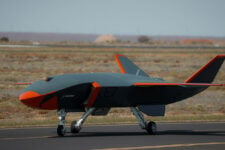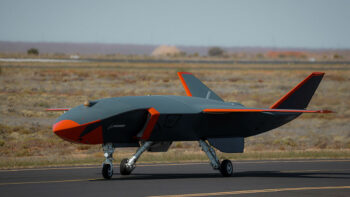
Staff Sgt. David Diehl II, 436th Communications Squadron noncommissioned officer in charge of wing cybersecurity, displays his new United States Space Force tapes and service branch patch at Dover Air Force Base, Delaware, Feb. 12, 2021. (U.S. Air Force photo by Mauricio Campino)
WASHINGTON — The Pentagon’s fiscal 2025 budget request essentially flatlines the Space Force’s coffers at just under $30 billion per year through the next five years — a number that does not support the service’s ambitions to fundamentally remake its current satellite networks to provide more advanced capabilities, according to two veteran space budget analysts.
“Space Force is … no special child and is subject to that same Fiscal Responsibility Act top-line, and we’re starting to see the impact thereof,” Mike Tierney, a long-time space budget guru who is now chief of legislative affairs at the National Security Space Association (NSSA), said on Tuesday during an NSSA webinar.
“This particular fiscal year transition, from ’24 to ’25, … is certainly an inflection point for the Space Force. We are now entering a period, at least it looks as though, of leveling out — focused on sustainment and readiness rather than the kind of year-over-year growth that we had seen that comes naturally with standing up a new force,” he added.
Tierney explained that the Space Force’s FY25 budget request is “2 percent above what they ultimately were appropriated in FY24, but it’s 2 percent below what they requested even last year,” a figure that doesn’t give the service enough room to ramp up.
Todd Harrison, senior fellow at the American Enterprise Institute, told NSSA that the Pentagon’s FY25 request makes clear that growing the service is no longer the top concern for the Defense Department in making budgetary tradeoffs.
“The Space Force is not growing in priority as it had been in previous years. The priority is shifting more towards the the Air Force and the Navy in the budget. The Space Force is kind of where the Army is: kind of just holding its own at this point,” he said.
Both analysts asserted that it will be impossible for the Space Force to meet its current mission goals if the FY25 projections for the next five years remain static.
“The short answer is no — I don’t think we can continue with a flat, with inflation, Space Force budget because we’re trying to get into new mission areas, and the Space Force is trying to get to more advanced capabilities, more resilient capabilities,” Harrison said. “It is going to cost more.”
Tierney agreed, noting that the House Appropriations Committee has already called the Space Force out for failing to fully fund its programs through the future years defense program (FYDP).
“If they want to do what they [say they] want to do, then it cannot be done in a level budget environment,” he said.
Harrison said one example is the fact that the service’s out-year projections for the Space Development Agency (SDA) do not reflect the “full costs of the programs that are in the pipeline now.” Specifically, he explained, the current service FYDP does not include funds to transfer its flagship Transport Layer data relay satellites and Tracking Layer missile warning/tracking satellites from research and development efforts to procurement buys.
“The missile warning Tracking Layer and the Transport Layer at some point very soon … should be transitioning from R&D funding into procurement funding. And those constellations, because the satellites will have a notional lifetime of like five years, they will require sustained funding to keep the constellation viable, right?,” he said. “So, where is that? It’s not in the budget request.”
Nor should Space Force (or Pentagon) leadership think that Congress is going to be willing to bail the service out by significantly bolstering its requests, the two analysts warned.
“There’s no guarantee, especially in this constrained fiscal environment, that somehow space gets off scot-free and we get a an increase over the request, especially in this kind of new environment,” said Tierney.






















